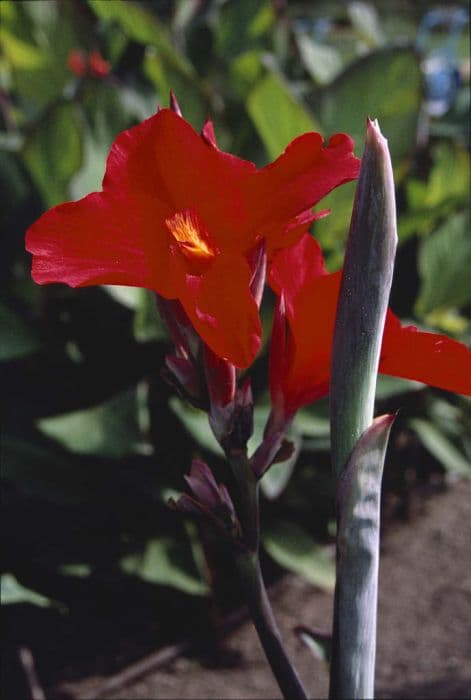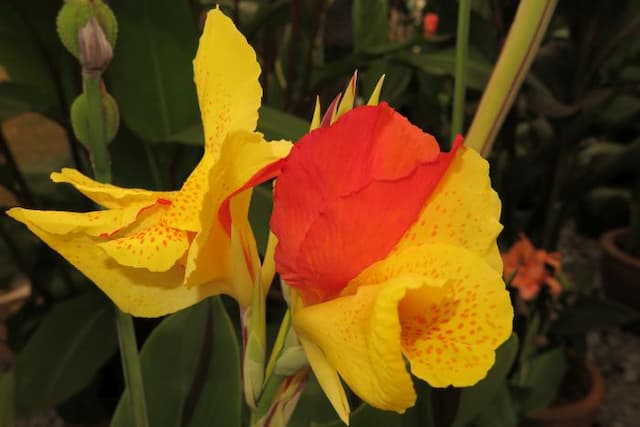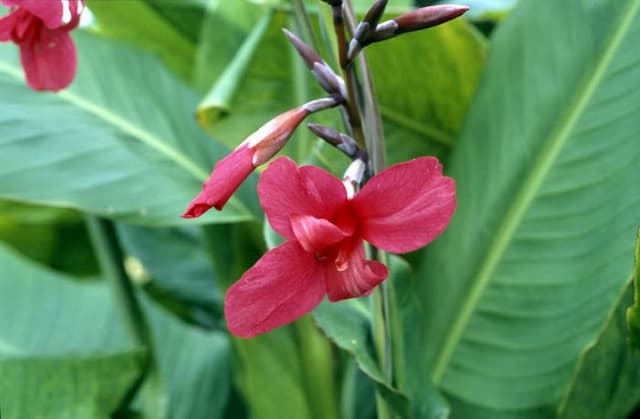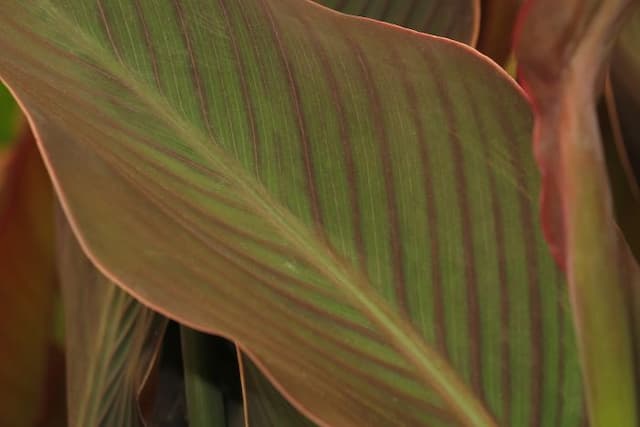Canna Lily Canna 'Schwäbische Heimat'

ABOUT
The Canna 'Schwäbische Heimat' is a vibrant perennial plant that adds a touch of the exotic to any garden with its striking appearance. This cultivar of Canna is known for its lush, sizeable, banana-like green leaves which create a dramatic backdrop for its flowers. The blossoms are the real showstoppers, typically amassing in clusters atop the tall stems that rise among the leaves. Vivid and bold, the flowers of 'Schwäbische Heimat' possess a fiery color palette, usually a blend of warm tones such as oranges, reds, and yellows, sometimes having a speckled or multicolored look that enhances its visual appeal. The petals have a gently ruffled or wavy edge, giving them a textured and dynamic expression as if they're dancing in the breeze. Each flower comprises several petal-like structures, some forming a tube-like shape at the base, characteristic of Canna blooms. The plant showcases a tropical aesthetic, and despite its lushness, it has a certain orderly growth habit that makes it suitable for various garden styles. It is often planted in masses for a stunning display, but it can also serve as an attractive solitary specimen. After flowering, the Canna 'Schwäbische Heimat' produces seed pods that are green, roundish, and then dry to a brownish color, adding further interest to the plant's life cycle. Overall, this Canna is a flamboyant and robust addition to the landscape, bringing with it a flair of summer warmth and cheer.
About this plant
 Names
NamesFamily
Cannaceae.
Synonyms
Canna Lily, Canna.
Common names
Canna 'Schwäbische Heimat'.
 Toxicity
ToxicityTo humans
Generally, the Canna lily is not considered to be toxic to humans. There are no significant reports of poisoning from ingestion of this plant. Thus, should you or someone you know ingest a part of a Canna lily, it is not expected to cause serious harm. However, as with any non-edible plant, individual reactions can vary, and it could potentially cause mild stomach upset in some people.
To pets
Canna lily is also generally considered non-toxic to pets. If a pet were to ingest part of this plant, it is not expected to lead to serious illness. While there's typically no need for concern, ingestion of plant material can sometimes lead to mild gastrointestinal upset in pets, such as vomiting or diarrhea, especially if a large amount is consumed. It's always wise to monitor your pet for any signs of discomfort and consult with a veterinarian if any adverse reactions are observed.
 Characteristics
CharacteristicsLife cycle
Perennials
Foliage type
Deciduous
Color of leaves
Green
Flower color
Orange
Height
3-4 feet (90-120 cm)
Spread
1-2 feet (30-60 cm)
Plant type
Bulb
Hardiness zones
7
Native area
South America
Benefits
 General Benefits
General Benefits- Aesthetic Appeal: Canna 'Schwäbische Heimat' adds a vibrant splash of color to gardens with its striking flowers and foliage.
- Pollinator Attraction: The flowers can attract hummingbirds and butterflies, supporting local biodiversity.
- Easy Maintenance: This Canna variety is known for being relatively easy to care for, making it suitable for gardeners of all skill levels.
- Drought Resistance: Once established, it can tolerate periods of drought, reducing the need for frequent watering.
- Versatility in Landscaping: It can be used in borders, as a focal point, or in mass plantings for dramatic effect.
- Fast Growth: Provides quick coverage and a rapid transformation of garden spaces.
- Tolerance of Heat: It can survive and thrive in hot climates, making it ideal for warm regions.
- Seasonal Interest: This plant boasts a long blooming season, keeping gardens lively from late spring through to fall.
- Soil Adaptability: It is adaptable to a variety of soil conditions, as long as there is good drainage.
- Herbivory Resistance: The foliage and flowers are less appealing to deer, which can help reduce damage to the plant.
 Medical Properties
Medical PropertiesThis plant is not used for medical purposes.
 Air-purifying Qualities
Air-purifying QualitiesThis plant is not specifically known for air purifying qualities.
 Other Uses
Other Uses- Canna Lily can be used as a natural pest deterrent in the garden because some pests tend to avoid its foliage.
- The sturdy foliage of Canna Lily can provide a microclimate for smaller plants by offering shade and humidity control.
- Canna Lily rhizomes have been used historically to make paper due to their high fiber content.
- The Canna Lily's seed has a hard shell that can be used as a bead for jewelry and ornamental purposes.
- Canna Lily can serve as a biological water filter when planted in boggy areas or around pond edges.
- The large leaves of Canna Lily can be used as a natural wrapping material for food, similarly to banana leaves in some cultures.
- Canna Lily stalks, due to their strength and flexibility, have been used in some places to craft fishing rods.
- Planting Canna Lily en masse can help reduce soil erosion with its dense root system.
- The colorful Canna Lily can be planted in patterns to create living art or floral displays in landscapes.
- Dry Canna Lily leaves can be used to create eco-friendly packing material or as a stuffing for scarecrows and doll making.
Interesting Facts
 Feng Shui
Feng ShuiThe Canna Lily is not used in Feng Shui practice.
 Zodiac Sign Compitability
Zodiac Sign CompitabilityThe Canna Lily is not used in astrology practice.
 Plant Symbolism
Plant Symbolism- Fiery Passion: Often, Canna flowers come in vibrant reds and oranges, which can symbolize intense emotion and passion, reflecting the fiery colors of the blooms.
- Confidence and Pride: With their tall stature and bold colors, Cannas can embody confidence and a sense of pride in oneself.
- Creativity: The unique and artistic shape of Canna flowers may represent creativity and an unconventional approach to life.
- Tropical Energy: Native to tropical areas, Cannas can symbolize a relaxed, tropical energy or lifestyle.
- Provision and Survival: As Canna plants are edible and have been used in some cultures for food, they can symbolize provision and survival.
 Water
WaterCanna lilies should be watered deeply and thoroughly to encourage the growth of strong roots, which means allowing the water to soak down to the roots rather than just wetting the surface. They prefer consistently moist soil, so watering once or twice a week may be necessary, especially during hot, dry periods. Provide about one to two inches of water each time, which is roughly equivalent to 0.62 to 1.24 gallons per square foot, every week. Be careful not to overwater, as this can lead to root rot. During the winter months when the plant is dormant, reduce watering significantly to prevent the tubers from rotting.
 Light
LightCanna lilies thrive in full sun, needing at least 6 to 8 hours of direct sunlight each day to bloom well and maintain healthy growth. A spot that receives morning sunlight and some partial shade in the afternoon is ideal to protect the leaves from scorching during the peak heat of day. However, they can tolerate some light shade, especially in regions with very hot summers.
 Temperature
TemperatureCanna lilies prefer warm temperatures and are hardy in USDA zones 7 through 10. They can withstand high temperatures well above 90°F without problems as long as they are provided with enough water. The minimum temperature they can tolerate is around 55°F, but for optimal growth, they should be kept in temperatures ranging from 70°F to 90°F. If frost is expected, the rhizomes should be dug up and stored in a frost-free location.
 Pruning
PruningPruning canna lilies involves deadheading spent blooms and removing damaged or diseased leaves to encourage new growth and more blooms. This should be done throughout the blooming season as needed. The best time for pruning is when the flowers fade or the foliage shows signs of distress. Cut back foliage to the ground at the end of the blooming season to prepare the canna for winter dormancy.
 Cleaning
CleaningAs needed
 Soil
SoilThe best soil mix for Canna Lily 'Schwäbische Heimat' is a well-draining, fertile loam or sandy soil enriched with organic matter. The soil pH should be slightly acidic to neutral, ranging from 6.0 to 7.0 for optimal growth.
 Repotting
RepottingCanna Lily 'Schwäbische Heimat' should be repotted every two to three years to replenish nutrients and accommodate growth. It is best to repot in the spring just before the growing season begins.
 Humidity & Misting
Humidity & MistingCanna Lily 'Schwäbische Heimat' thrives in moderate to high humidity levels, typically between 50-70%. Consistent humidity encourages healthy foliage and vibrant blooms.
 Suitable locations
Suitable locationsIndoor
Provide bright light, keep soil moist, and ensure high humidity for indoor Canna Lily.
Outdoor
Plant in well-draining soil, full sun, and water regularly for outdoor Canna Lily.
Hardiness zone
7-11 USDA
 Life cycle
Life cycleCanna 'Schwäbische Heimat' begins its lifecycle with seed germination or sprouting of underground rhizomes in the spring when soil temperatures warm. During the growth stage, the plant develops large, ornamental leaves and a sturdy stem, eventually reaching its full size. Throughout the summer, the Canna 'Schwäbische Heimat' produces vibrant blooms that attract pollinators, with a succession of flowers replacing those that fade. After flowering, it sets seeds if pollination has occurred, though many varieties, including cultivars like 'Schwäbische Heimat,' are often propagated vegetatively. As temperatures cool in the fall, the plant's foliage starts to wither; the Canna then enters dormancy, with the rhizomes storing energy underground during the winter. When the next spring arrives, the cycle commences anew with the rhizomes producing new shoots, repeating the annual cycle of growth, flowering, and dormancy.
 Propogation
PropogationPropogation time
Spring-Summer
Canna 'Schwäbische Heimat', commonly known as Canna Lily, is typically propagated through division of its rhizomes. This method is both simple and effective, favored for its ability to quickly produce exact clones of the parent plant. The ideal time for dividing Canna Lilies is in the spring, just before the growing season begins, when the plant is emerging from dormancy. To propagate, gardeners should carefully lift the Canna Lily clump from the ground and use a sharp knife or spade to slice the rhizome into sections, ensuring that each section has at least one eye, which is a growing point. The divisions should then be replanted at a depth of 3 to 4 inches (approximately 7.5 to 10 cm) in warm, moist soil, spacing them about 1 to 2 feet (30 to 60 cm) apart to allow for adequate growth. It's important to water the newly planted rhizomes well to help establish them. With proper care, these divisions will quickly develop into mature, flowering Canna Lilies.









